A-G
An AI file is a vector graphic saved in the Adobe Illustrator Artwork (AI) format. It is created by Adobe Illustrator or exported by another graphics application, such as Adobe Photoshop. AI files are saved in a vector format comprising paths connected by points rather than bitmap image data, allowing users to enlarge them without losing image quality.
More Information
Adobe Illustrator is one of the most common vector graphics applications and a favorite among graphic artists, visual artists, and web designers. They use the application to design vector artwork, such as icons, logos, and web & mobile layouts.
How to create an AI file with Illustrator
When you save artwork in Illustrator, the application creates an AI file to store the contents of the design. After saving the file, you can close it, re-open it, and continue editing the artwork. To create an AI file with Illustrator, select File → New, modify your artwork, then select File → Save or Save As….
How to open an AI file
You can open an AI file with Adobe Illustrator in Windows and macOS. Illustrator is the best option for opening AI files because it fully supports the formatting of Illustrator artwork. To open an AI file with Illustrator, select File → Open.
You can also open AI files with other third-party applications, such as ACD Systems Canvas (Windows), CorelDRAW Graphics Suite (Windows and macOS), GIMP (multiplatform), and Inkscape (multiplatform). Remember that these applications may not fully support the AI format, or they may rasterize the image, meaning the vector data will be converted to a bitmap format.
💡 If you are a Mac user, you can also view AI files with Apple Preview, which is bundled with macOS.
The extension of an image beyond the final trimmed edge of a piece. Usually this is the background image, and can simply be a solid background color.
The bleed is the area that non-visible in the final product as it will be folded and sewn. This is why it is important to make sure no text or images that are intended to be visible on the final product, are in the bleed area
Stands for “Cyan Magenta Yellow Black,” or “Cyan Magenta Yellow Key.”
CMYK is a color model used for printing color images. It separates colors into four channels — cyan, magenta, yellow, and black. These colors correspond to the four ink colors used in home and commercial printers.
Graphics and documents must be converted from RGB into CMYK before printing, either by image editing software or automatically by the printer driver. Some colors may appear duller after conversion to CMYK due to differences between the two models. RGB color spaces typically have a larger color gamut, since computer monitors can display more colors than mixed inks.
Unlike RGB and most other color models, CMYK is a subtractive model. All four CMYK color sliders set to 0% creates white, since that value represents the lack of ink on a blank page. Increasing the value of each color slider results in darker colors as more ink is added, until each slider at 100% results in black.
CMYK color uses black ink in addition to the three colored inks for several reasons. Black ink is cheaper than color ink, so it is more efficient to use it whenever possible. Black ink also produces a truer black than a combination of color inks due to impurities present in the colors. Creating black by mixing colors also requires that the print heads or plates for the three colors are perfectly aligned; otherwise, text, lines, and other details will blur.
The “K” in the abbreviation represents black ink, but it actually stands for “key.” This term comes from the plates used in a commercial four-color printing process. The three color ink plates create the areas of color on the page, but the black ink plate is responsible for the contrast and fine details in the resulting image. As a result, the black ink plate is known as the “key plate.”
A standard that measures the flame resistance of fabrics used in tents and other outdoor gear. The Canvas Products Association International (CPAI), now known as the International Fabrics Association International, created the standard in 1976.
The CPAI-84 test evaluates how a fabric resists fire by measuring the length of charring and the amount of mass lost to burning. The test process includes:
Testing the material in its original state, weathered, and after leaching
Applying a flame to the material for four seconds
Measuring the length of damage caused by the flame
Is when there is printing on both sides of the fabric. This is accomplished by sewing two pieces of fabric together. This is usually preferred on walls of booths that are open and the inside is visible.
Stands for “Dots Per Inch.” DPI is used to measure the resolution of an image both on screen and in print. As the name suggests, the DPI measures how many dots fit into a linear inch. Therefore, the higher the DPI, the more detail can be shown in an image.
It should be noted that DPI is not dots per square inch. Since a 600 dpi printer can print 600 dots both horizontally and vertically per inch, it actually prints 360,000 (600 x 600) dots per square inch.
Also, since most monitors have a native resolution of 72 or 96 pixels per inch, they cannot display a 300 dpi image in actual size. Instead, when viewed at 100%, the image will look much larger than the print version because the pixels on the screen take up more space than the dots on the paper.
Is a printing process that transfers the ink to the fabric by heating it.
The process involves two steps:
- Print on transfer paper
A sublimation printer uses special inks to print graphics onto transfer paper. - Transfer the image
A heat press transfers the ink from the paper to the material. The heat turns the solid dye into a gas, which then penetrates the material and turns back into a solid, creating a permanent bond.
Dye sublimation printing has several advantages, including:
Durability: The ink is embedded into the material, so the image won’t fade, flake, or crack, even after multiple washes.
Quality: Dye sublimation produces high-resolution, vibrant images.
Glare-free: Fabric graphics printed with dye sublimation are glare-free, making them easy to see.
Environmentally friendly: Dye sublimation uses non-toxic inks, generates less waste, and consumes less energy and water than traditional printing methods.
An EPS file is a vector graphic saved in the Encapsulated PostScript (EPS) format. It contains PostScript-formatted image data, ideal for scaling high-resolution images, and may include bitmap image data and text. EPS files also store a low-resolution embedded bitmap image for previewing the graphic.
More Information
Adobe developed the EPS format in the late 1980s to become a standard for exchanging images across different platforms and devices. While various applications and users adopted the format, other image formats overshadowed it, such as .JPEG and .PNG.
Although EPS never became as widely used as Adobe intended, graphics professionals commonly save their artwork in the format, such as icons and drawings. For example, graphic designers often use professional vector image editors, such as Adobe Illustrator or Serif Affinity Designer, to save artwork as EPS files for large print jobs (e.g., posters, banners, and billboard advertisements) because of the format’s scalability.
How to open an EPS file
You can open an EPS file with various image editors, including Adobe Illustrator, QuarkXpress, and Serif Affinity Designer. For example, to open an EPS file with Illustrator, select File → Open.
Some other options include GIMP, which is a free cross-platform image editor, and CorelDRAW Graphics Suite, which is available for Windows and macOS.
A font is a collection of characters with a similar design. These characters include lowercase and uppercase letters, numbers, punctuation marks, and symbols.
Changing the font can alter the look and feel of a block of text. Some fonts are designed to be simple and easy to read, while others are designed to add a unique style to the text. For example, Arial has a simple, modern look, while Palatino has an older more traditional appearance.
Serif vs Sans-Serif Fonts
The two most basic categories of fonts are “serif” and “sans-serif.” Small extensions on the edges of characters, such as horizontal line on the bottom of a capital “T,” are called serifs. Fonts that include these small lines are called serif fonts. The word “sans” means “without,” so sans-serif fonts do not have these extra lines. Generally, serif fonts have a traditional appearance and are often used in printed books and newspapers. Sans-serif fonts have a more modern look and are commonly used on the web.
Most word processors allow you to select a font from a “Fonts” drop-down menu in the toolbar. You can apply a font to an entire document or to a section of highlighted text. In order to use a font, it must be installed on your computer. In Windows, you can add or remove fonts using the Fonts control panel, located in Control Panel → Appearance and Personalization → Fonts. In macOS, you can manage fonts using Font Book, located in the /Applications directory.
Font vs Typeface
Originally, the term “font” referred to a specific size and style of a typeface. For example, Verdana was a typeface and Verdana 16px bold would be a specific font. However, in recent years, the terms have been used interchangeably, with companies like Microsoft, Apple, and Google all using the term “font” to describe a typeface. Therefore, it is acceptable to refer to a typeface such as Roboto as a font.
H-P
Stands for “Joint Photographic Experts Group.”
JPEG is a popular image file format. It is commonly used by digital cameras to store photos since it supports 224 or 16,777,216 colors. The format also supports varying levels of compression, which makes it ideal for web graphics.
The 16 million possible colors in a JPEG image are produced by using 8 bits for each color (red, green, and blue) in the RGB color space. This provides 28 or 256 values for each of the three colors, which combined allow for 256 x 256 x 256 or 16,777,216 colors. Three values of 0 produce pure black, while three values of 255 create pure white.
The JPEG compression algorithm may reduce the file size of a bitmap (BMP) image by ten times with almost no degradation in quality. Still, the compression algorithm is lossy, meaning some image quality is lost during the compression process. For this reason, professional digital photographers often choose to capture images in a raw format so they can edit their photos in the highest quality possible. They typically export the pictures as JPEG (.JPG) images when they are shared or published on the web.
Besides image data, JPEG files may also include metadata that describes the contents of the file. This includes the image dimensions, color space, and color profile information, as well as EXIF data. The EXIF data is often “stamped” on the image by a digital camera and may include the aperture setting, shutter speed, focal length, flash on/off, ISO number, and dozens of other values.
Disadvantages of the JPEG Format
While the JPEG format is great for storing digital photos, it does have some drawbacks. For example, the lossy compression can cause an issue called “artifacting,” in which parts of the image become noticeably blocky. This typically happens when a high compression setting is used to save the image. For saving small images and images with a lot of text, the GIF format is often a better alternative. JPEG images also don’t support transparency. Therefore, the JPEG format is a poor choice for saving non-rectangular images, especially if they will be published on webpages with different background colors. The PNG format, which supports transparent pixels is more ideal for these types of images.
The Joint Photographic Experts Group, which the JPEG image format is named after, published the first JPEG specification in 1992. Since then, the organization has developed several variations of the format, including JPEG 2000 and JPEG XR. However, the standard JPEG format remains the most popular.
A fire retardancy test that measures how fabrics respond to ignition sources and is used to classify textiles for public spaces. The National Fire Protection Association (NFPA) develops this national standard, which is not a law or regulation, but state and local governments can make and enforce their own laws and regulations.
The NFPA 701 test involves exposing fabric samples to an open flame in a controlled chamber and assessing the following:
Char length: The length of damage caused by the flame moving upward
Flaming residue: The material fragments that fall to the bottom of the chamber
After-flame: The length of time the fabric continues to burn after the flame is removed
To pass the test, a fabric must meet the following criteria:
Have a char length of less than 6.5 inches
Have an after-flame of fewer than 2 seconds
Not continue to flame after reaching the floor
The triangle part on the canopy top. Each canopy has four peaks, all can be printed with different designs or the same.
A pixel (short for “picture element”) is the smallest element of a digital image displayed on screen — a single dot of color within a larger grid of dots that combine to form a picture. The word “pixel” can refer to both the physical element on a monitor capable of displaying a single dot of color and to the digital data representing each dot within a raster image file. The more pixels in an image or monitor, the higher its resolution and the more detail it can display.
Computer monitors and other screens contain a matrix of thousands or even millions of pixels. An individual pixel displayed on a monitor is often too small to be seen by the naked eye, with some HiDPI monitors containing more than 200 pixels per inch. Each pixel on a screen consists of three smaller subpixels (one each for red, green, and blue) that mix light into a single color.
Every raster (or bitmap) image consists of a grid of square pixels. Each pixel only displays a single color; combining thousands (or millions) of pixels allows the colors in those individual dots to blend smoothly. How many possible colors a pixel can display is determined by the image’s color depth — the number of bits it uses to store a single pixel. A color depth of 8 bits allows for 256 (28) possible color values, while a higher color depth of 24 bits allows each pixel to have one of more than 16 million (224) possible colors.
Stands for “Pantone® Matching System”.
This refers to the Pantone Matching System, a set of universal colors that all printers can replicate. Each Pantone color comes with CMYK, RGB, hexadecimal, and Pantone color codes. Using these codes improves consistency throughout print materials.
A color system based on over a thousand ink colors, unlike CMYK this uses inks that have been mixed prior to printing.
A universal color language that designers, printing companies and brand owners use. This helps the right color to be achieved again and again.
Stands for “Portable Network Graphics.”
A PNG is a compressed raster graphic file format that is a standard format for web graphics. It is suitable for most images, including illustrations, icons, and photographs. The PNG format supports 24-bit true color, lossless compression, and transparency.
In addition to JPEG and GIF, PNG is one of the most common image formats on the web. Introduced after JPEG and GIF had both become web standards, it includes features from both file types. It supports both 8-bit indexed color for low-color illustrations (like GIF) and 24-bit true color for photographs (like JPEG). It uses lossless compression to reduce file size without introducing any artifacts. However, this results in significantly larger files than lossy-compressed JPEG images.
Unlike either GIF or JPEG, PNG supports the RGBA color model. This adds an optional alpha channel with 256 levels of transparency instead of the single on-or-off level supported by the GIF format. Designers can gradually fade an image or include a subtle drop shadow that looks natural no matter what is behind it.
The PNG format was introduced in 1995 as a patent-free replacement for the GIF format. Since the GIF format used a patented form of data compression, the makers of software that supported GIF files were required to pay royalties. The PNG format was free to use and improved on several other shortcomings of the GIF format, but it was not widely supported by web browsers for several years after its introduction.
Two animated variants of the PNG format have been introduced: .MNG and .APNG. MNG failed to achieve widespread software support; APNG, while less common than the animated GIF format, is now supported by all major web browsers.
Stands for “Pixels Per Inch.”
The resolution of a printed photo is often measured in DPI, or “dots per inch.” The DPI describes how many dots of ink the printer prints per line per inch. Therefore, the higher the DPI, the greater the detail of the printed image. However, even if a photo is printed with a high DPI, the detail represented in the photo can only be as high as the PPI.
PPI measures the number of pixels per line per inch in a digital photo. This number is directly related to the number of megapixels a digital camera can capture. For example, the original Canon Digital Rebel is a 6.3 megapixel camera and captures 2048 vertical by 3072 horizontal pixels. Therefore, when printing a 4×6 image, the PPI would be 3072 px. / 6 in. = 512 PPI. That is high enough to print a very detailed 4×6 photo. However, if you were to print a large 20×30 poster image from a 6.3 megapixel image, the PPI would be 3072 px. / 30 in. = 102.4 PPI.
Most modern printers print images with a minimum resolution of 300 DPI. Therefore, if you print a photo with a PPI of less than 300, you may notice the image is not as sharp as you would like. Of course, the detail in a 20×30 image may not need to be as clear as a 4×6 photo. But a good rule of thumb is to keep your PPI above 300 so your prints will look nice and clear.
Q-Z
Raster graphics are computer graphics that consist of a grid of pixels, also known as a bitmap. Most images on the Internet and your computer are raster graphics. They are one of the two primary image types for computer graphics with vector graphics.
The file size of a raster graphic depends on several variables. The first is a raster graphic’s image size, also known as its resolution — the number of pixels it is wide by the number of pixels it is tall. A higher-resolution image has more pixels and thus requires more disk space to store. For example, an image 640 pixels wide by 480 pixels tall consists of 307,200 pixels total, while a larger 3072 x 2048 image requires 6,291,456 pixels. A raster graphic’s file size also depends on its color depth — how many bits of data each pixel requires. An image with 8 bits of color depth can only display 256 colors. An image with 24 bits of color depth uses three times as much data but can use more than 16 million colors.
Since raster graphics consist of a grid of pixels, resizing one to change its resolution will necessarily change the contents of those pixels. Shrinking one down requires the data from multiple pixels to be combined, causing fine details to be lost. Scaling one up requires creating new data between the existing pixels, which can result in an image that’s either blurry or blocky.
There are many file formats used for raster graphics, some of which include image compression to reduce file size. For example, a large bitmap image saved in the lossy JPEG format will have a smaller file size than the same bitmap image saved as a losslessly-compressed PNG file, which in turn will be smaller than that image saved as an uncompressed BMP file.
Resolution measures the number of pixels in a digital image or display. It is defined as width by height, or W x H, where W is the number of horizontal pixels and H is the number of vertical pixels. For example, the resolution of an HDTV is 1920 x 1080.
Image Resolution – A digital photo that is 3,088 pixels wide by 2,320 pixels tall has a resolution of 3088 × 2320. Multiplying these numbers together produces 7,164,160 total pixels. Since the photo contains just over seven million pixels, it is considered a “7 megapixel” image. Digital camera resolution is often measured in megapixels, which is simply another way to express the image resolution.
“Resolution” is often used synonymously with “size” when describing the dimensions of a digital image. However, the term “size” can be a bit ambiguous, since it may refer to the file size of the image or its dimensions. Therefore, it is best to use “resolution” when describing the dimensions of a digital image.
Display Resolution
Every monitor and screen has a specific resolution. A “Full HD” display has a resolution of 1920 x 1080 pixels. A 4K display has twice the resolution of Full HD, or 3840 x 2160 pixels. It is called “4K” since the screen is nearly 4,000 pixels across horizontally. The total number of pixels in a 4K display is 8,294,400, or just over eight megapixels.
Monitor resolution defines how many pixels a screen can display, but it does not describe how fine the image is. For example, a 27″ iMac 5K display has a resolution of 5120 x 2880 while an older 27″ Apple Thunderbolt Display has exactly half the resolution of 2560 x 1440. Since the 27″ iMac is the same physical size as the Thunderbolt Display but has twice the resolution, it has twice the pixel density, measured in pixels per inch, or PPI.
Unlike monitor resolution, the resolution of a printer or scanner is analogous to pixel density rather than total pixels. Printer and scanner resolution is measured in dots per inch, or DPI.
Stands for “Red Green Blue.”
RGB refers to three hues of light that can be mixed together to create different colors. Combining red, green, and blue light is the standard method of producing color images on screens, such as TVs, computer monitors, and smartphone screens.
The RGB color model is an “additive” model. When 100% of each color is mixed together, it creates white light. When 0% of each color is combined, no light is generated, creating black. It is sometimes contrasted with CMYK (cyan, yellow, magenta, and black), the standard color palette used to create printed images. CMYK is a “subtractive” color model since the colors get darker as they are combined. Blending 100% of each color in the CMYK color model produces black, while 0% of each color results in white.
How many colors can be created using RGB?
The number of colors supported by RGB depends on how many possible values can be used for red, green, and blue. This is known as color depth and is measured in bits. The most common color depth is 24-bit color, also known as “true color.” It supports eight bits for each of the three colors, or 24 bits total. This provides 28, or 256 possible values for red, green, and blue. 256 x 256 x 256 = 16,777,216 total possible colors in the “true color” palette.
The human eye can only distinguish about seven million colors, so color depths above 24-bit are rarely used.
RGB Example
When displaying a color image on a screen, each pixel has a specific RGB value. In 24-bit color, this value is between 0 and 255, where 0 is no color and 255 is full saturation). A purple pixel will have a lot of red and blue, but little to no green. For example, the following RGB value might be used to create purple:
R: 132 (84 in hexadecimal)
G: 17 (11 in hexadecimal)
B: 170 (AA in hexadecimal)
Since each color has 256 possible values, it can also be represented using two hexadecimal values (16 x 16), as shown above. The standard way to display an RGB value is to use the hexadecimal values for red, green, and blue, preceded by a number symbol, or hashtag. Therefore, the purple color above is defined in RGB as #8411AA.
Is when there is only printing on one side of the fabric. This is often used on the walls on the Food Booth PRO as the inside of the booth is usually not visible. It also makes the walls lighter and easier to work with. You can also add our undercoating option that makes the walls easier to clean and maintain.
An SVG file is an image saved in the Scalable Vector Graphic format. The vector graphic it contains can be scaled to any size without losing quality. For this reason, digital illustrators often save logos, charts, and other graphics intended to be shown at a variety of sizes as SVG files.
More Information
The World Wide Web Consortium (W3C) developed the SVG format and released its initial version in 2001. Since then, W3C has released several updates to the SVG format, including SVG 1.1, SVG Tiny 1.2, and SVG 2.0.
Unlike .JPG, .PNG, and other raster image files, SVG images are not comprised of pixels. Instead, SVG images are defined using XML-like text that describes how the image should appear. For example, when opened in a text editor, an SVG file might look like this:
<svg xmlns="http://www.w3.org/2000/svg" viewBox="0 0 93 107"> <path d='M74,74a42,42 0,1,0-57,0l28,29a42,41 0,0,0 0-57' fill='#00a3dc' fill-rule='evenodd'/> </svg>
What SVG files are used for
Because the image an SVG file describes is defined using text-based paths, rather than pixels, it can be scaled up or down without losing any quality. This is why digital illustrators save logos and icons, which need to be shown or printed at a variety of sizes, as SVG files.
Web developers also often publish SVG files on webpages, since the graphics they contain will look good at any resolution, and search engines can read the text the files contain (which may help with search engine page ranking). These developers can also modify SVG images using CSS and scripting languages (such as JavaScript) if needed.
How to create an SVG file
Various vector graphics editors allow you to save graphics as SVG files. Some popular vector graphics editors that can create SVG files include:
If you need to reduce an SVG’s file size (for example, to make it easier to share online), you can export it as an .SVGZ file. This compresses the image with gzip compression, reducing its file size by 50 to 80 percent.
How to open an SVG file
You can open an SVG file and edit the image it contains with Adobe Illustrator, CorelDRAW, Inksca
If you just want to view the image your SVG file contains, you can open it by dragging it into your web browser (or selecting File → Open…). Google Chrome, Microsoft Edge, Apple Safari, and Mozilla Firefox can all display SVG images.
Advanced users may want to open their SVG file in a text editor, such as Microsoft Notepad or Apple TextEdit, to view or edit the XML-style text the file contains. However, most users are better off opening an SVG file in a vector graphics editor or web browser.
A pre-designed layout used to digitally design or set up artwork to ensure consistency and appearance.
The rectangle part on the canopy top. This is the most legible and visible are of the canopy and is usually used for information like a website, social media, slogan or best selling products. Each canopy has four valances, all can be printed with different designs or the same.
TIFF is an image file format for storing raster graphics. It is a versatile format that supports advanced features like layers, transparency, and multi-image files, although not all image programs support every feature. TIFF files can be high quality but are often much larger than other image types.
The TIFF format uses tags to store metadata for the image or images a file contains. These tags give the TIFF format its versatility — tags in a file’s header define the image size, color depth, compression settings, and other information about each image in the file. Since TIFF files may contain multiple images, this allows each image in a file to have its own properties separate from the rest. TIFF files may also include private tags for special-purpose data, like GPS coordinates for high-resolution GIS imagery.
Since the TIFF format has been in use since the 1980s, it’s one of the most well-supported and widely-used image formats. It is a standard format used in the publishing, photography, and graphic design industries for storing and sharing high-quality images. Long-term image archival often uses TIFF files because the built-in lossless compression minimizes file size while perfectly preserving image data.
TIFF Extensions
Not every program that can open a TIFF file supports every feature. All programs that open and edit TIFF files must include a basic set of features called Baseline TIFF. These features include 1- to 24-bit color for grayscale, indexed color, or full RGB. They also include multiple subfiles within a single TIFF file and basic lossless compression.
Optional TIFF Extensions add more features. These include additional color spaces like CMYK, YCbCr, and Lab. Extensions also support more compression methods like lossless LZW and lossy JPEG, and an alpha channel to add transparency to an image. TIFF files saved in one program might not display correctly in another program that supports fewer features.
A vector graphic is a digital image comprised of points, paths, curves, and geometric shapes. Unlike raster graphics, which use a fixed grid of pixels, vector graphic files have no fixed resolution and can be resized, stretched, and otherwise manipulated without any quality loss. Graphic designers and illustrators use vector graphics for simple drawings, logos, icons, and illustrations. The individual characters in a font file are also vector graphics.
Paths in a vector graphic consist of points linked together. A point along a path can represent a sharp corner or a smooth curve (known as a bézier curve). When a path forms a closed loop by linking the end back to the beginning, it becomes a solid shape. You can adjust a path’s stroke to change its width, style, and color; you can also fill an enclosed shape with a color or gradient.
A vector graphic’s file size is typically much smaller than that of a raster graphic. A vector graphic file saves the mathematical information that defines the paths and shapes, along with their stroke and fill properties. Since this information is all stored as numerical values instead of individual pixels, a complicated vector graphic will have a smaller file size than a similarly-detailed raster graphic.
Common vector graphic file types include Adobe Illustrator (.AI), Encapsulated PostScript (.EPS), and Scalable Vector Graphic (.SVG).










